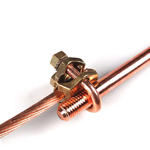The difference between passive and active lightning rods
- Post author:armaghan kia
- Post published:January 31, 2024
- Post category:Lightning Protection
- Post comments:0 Comments


Lightning rods, also known as air terminals or lightning conductors, are designed to protect structures from lightning strikes by providing a path of least resistance for the electrical discharge to follow, thus preventing damage to the building. Passive and active lightning rods represent two different approaches to achieving this goal:
Passive Lightning Rods:
Traditional Rods:
- Passive lightning rods are the traditional and more commonly used type.
- They are typically made of metal, often copper or aluminum.
- The rod is installed at the highest point of a structure, and it provides a direct path for lightning to follow to the ground.
- Passive rods rely on the principle that a pointed conductor will facilitate the easy discharge of lightning.
No External Power Source:
- Passive lightning rods do not require an external power source or any active components.
- They work based on the principles of charge dissipation and the creation of a preferential path for lightning to follow.
Active Lightning Rods:
Electrostatic Charging:
- Active lightning rods use an electrostatic charging mechanism to enhance the ionization of air around the rod.
- By actively charging the air, they aim to create an environment that is more conducive to the initiation of a lightning discharge.
Requires External Power:
- Active lightning rods need an external power source to function. This power source is typically supplied by batteries or other electrical systems.
Dynamic System:
- The system actively monitors atmospheric conditions and adjusts its operation based on the likelihood of a lightning strike.
- Some active systems claim to be able to trigger lightning strikes away from the protected structure by influencing the electrical conditions in the surrounding atmosphere.
Differences:
Operation:
- Passive rods operate based on the principles of charge dissipation and providing a path of least resistance.
- Active rods actively influence the atmospheric conditions around them to enhance ionization and potentially control the initiation of lightning.
Power Requirement:
- Passive rods do not require external power.
- Active rods require an external power source for their operation.
Complexity:
- Passive rods are simpler in design and operation.
- Active rods are more complex, incorporating additional components to actively influence the surrounding atmospheric conditions.
In practice, passive lightning rods are more commonly used and widely accepted, as they have a long history of effectiveness. Active systems, while theoretically interesting, are not as commonly deployed and may involve more complex installation and maintenance requirements. The choice between passive and active lightning protection systems depends on factors such as cost, complexity, and the specific requirements of the structure being protected.



